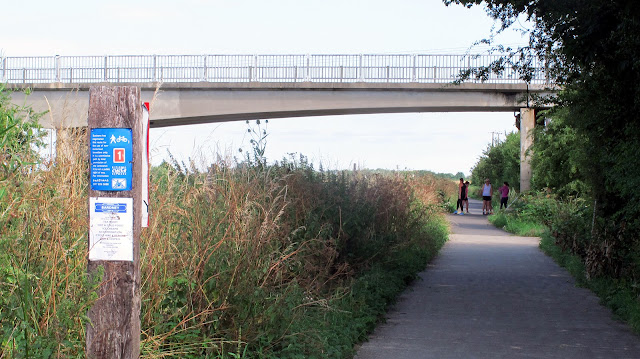 |
| The Water Rail |
The Water Rail Way runs alongside the River Witham between Lincoln and Boston, forming part of National Cycle Network Route 1, and Woodhall Spa stands at the halfway mark, so it is a good place from which to ride in either direction. In May 2015 we looked at the ride to Boston and here we look at the ride to Lincoln.
The 17 mile route is, apart from the climb up to the Cathedral, flat and almost entirely traffic free.with an impressive collection of sculptures and lots of information boards giving details of the history of the area.
Lincoln has a railway station but Woodhall Spa does not, so if travelling by rail, best to start the ride at Lincoln. No car parking problems in Woodhall Spa and it has good camping facilities, so the best start point if you are not travelling by train.
This is the beautiful city of Lincoln, our destination on this ride.
And here is Woodhall Spa. To access the riverside path we follow the main street heading SW out of town towards the Kirkstead Bridge.
The road goes over the bridge, but the path to Lincoln goes beneath it, so bear left after this filling station.
Off we go then. Note that the surface is good tarmac and this goes for most of the route.
A mileage check here.
The river meanders through the flat landscape and the path follows it for most of the way, but the floodbanks obscure views in places.
Lots of recreational boating to be seen as there are plenty of mooring berths at Lincoln and Boston, besides many between.
From a distance you might think that these sheep were real, but they are in fact made of scrap metal.
As a closer look will verify.
This is the first of many items of sculpture, some in metal and some are wood carvings, that you will find along side the path.
This wood carving is of a daisy, and was presumable carved on site with a chain saw. Amazing!
There are several old railway buildings and stations along this route which have been converted into very desirable domestic properties. This one, at Stixwold, has a most appropriate extension in the style of the old signal box.
Another sculpture here and this one makes you think.
What is it? What is it made of? How was it made?
I think that it represents the human form and it is certainly made of wood, in fact two pieces of wood,as there is a vertical joint right down the middle so that the holes are actually cut as depressions in the sides of each half before they were joined together.
Southrey Station, bearing a striking resemblance to Stixwold Station.
We leave the riverside going onto the Summer Route which crosses these arable fields and could prove difficult in adverse weather conditions. The Winter Route goes on road.
Mileage check on the field path.
Another reason for this route is the presence of this sugar factory which stands beside the river.
The field path leads to the highway which passes through Bardney village. Turn left here.
In Bardney there is this Railway Heritage Centre which is well worth a visit. Apart from lots of railway and military memorabilia there is also a cafe.
And you can even obtain overnight accommodation in these fitted out ex railway vans.
From the Heritage Centre we go back onto the riverside path through this entrance. The road goes over the river and the entrance to the sugar factory is just out of shot to the left.
The path is tarmac now all the way to Lincoln.
And soon we arrive at Bardney Bridge, the refurbishment of which was pivotal in the opening of the Water Rail Way a few years ago. The opening ceremony was a day to remember with a party on the bridge. There was a hog roast, a jazz band and people came from all the surrounding villages to join in the fun.
Close by the bridge sits another sculpture, but this basking shark (?) seems to have lost part of it's lower jaw.
On the other side of the bridge is this lock which controls the waters of the rather complicated river/canal system.
And yet another wood carving with the young lady holding my bike for the photograph.
This is Five Mile Bridge, which, would you believe, is five miles from Lincoln. We do not cross it, but keep to the left bank of the river.
More artwork across the path, and below
two cows made from re-cycled scrap metal.
Washingborough station is being re-furbished to make a very desirable house.
As we approach Lincoln we see the Cathedral standing proudly on the ridge above the city.
On into Lincoln now and the rest of the route is not so good, passing though a car park and subject (in July 2015) to diversions due to construction work.
But find your way through the pedestrianized shopping areas and brace yourself for the climb ( ie walk) up this steep hill which is called, (guess what), Steep Hill.
The reward for your effort is views of the magnificent Cathedral and it's surroundings.






















































































